Council for the Eruption
of the Marvelous
In Honor of the Arrival of the
Weathermen
Billy Graham Presents
Fragmentary Opposition
The dance of revolution
Is This Our Fate?
The End of CPE
You are wandering...
Godard Disruption
Address to Women’s Liberation
Gloria and Monica
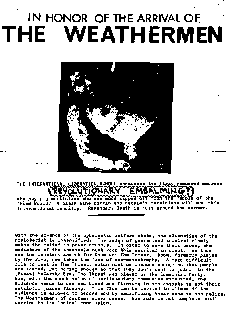
IN HONOR OF THE ARRIVAL
OF THE WEATHERMEN
[Photo of Che Guevara’s corpse]
The International Liberation School announces its first required course:
REVOLUTIONARY EMBALMING!
Why pay pig morticians who use wood ripped off from the People
of the Third World? A plain pine coffin and People’s Morticians will end
this international banditry. Remember, Death is just around the corner.
* * *
With the advance of the cybernetic welfare state, the alienation of the
proletariat is intensified. The reign of guaranteed survival slowly makes the belief in
power crumble. In order to save their power, the mediators of the spectacle must keep this
survival in doubt. We thus see the constant search for Doom and The Threat. Doom, formerly
played by The Bomb, now takes the form of eco-catastrophe. A more difficult role to cast
is The Threat, which must be ominous enough so that people are scared, yet boring enough
so that they won’t want to join. In the (first) McCarthy Era, The Threat was played
by the Communist Party. Now, with the shock value of parliamentary communism exhausted,
the Audience needs to see red blood and fighting in the streets to get their patriotic
juices flowing. This flow can be carried to climax if the Audience is allowed to become
God by sacrificing their sons to the police. The Weatherman, of course, plays Jesus. His
role is not complete until carried to its logical conclusion.
[January 1970]
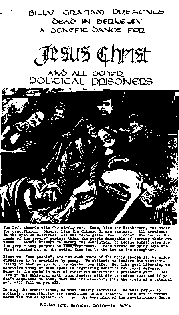
Billy Graham Presents
Dead in Berkeley
a Benefit Dance for Jesus Christ
and All Other
Political Prisoners
[Painting of crucifixion, with photos of the Chicago
Eight pasted over the heads of Jesus and the saints]
The Left abounds with Christ-figures. Some, like the Weathermen, volunteer
for crucifixion. Others, like the Chicago 8, are captured. All acquiesce to the Myth of
Sacrifice; all are false gods. Those leaders who “serve the needs of the people”
perhaps think the people incapable of serving their own needs. Leaders attempt to embody
the Revolution, to become substitutes for the people they purport to lead/represent. These
heroic whipping boys are first singled out by the media, then led by the Law to the
slaughter. Since we, “the people,” are not such stars of the media spectacle, we
allow ourselves to be crucified by proxy. We abdicate to leaders the responsibility of
each person to live his/her own life. So, like good liberals, we sacrifice money or time
spent in organizing benefits for legal defense. Money is the symbolic turd of vicarious
sacrifice; a poisonous gift. Just like in the Christian myth: your leaders will die to
redeem you; and if you don’t acquiesce to them, then the “repression,” like
the wrath of a paternal god, will fall on you all. To stop the crucifixions, we must
destroy sacrifice. We must refuse to abdicate responsibility for revolution to any
leaders. This act of refusal marks the end of mystification and the beginning of the
revolutionary dance.
[January 1970]
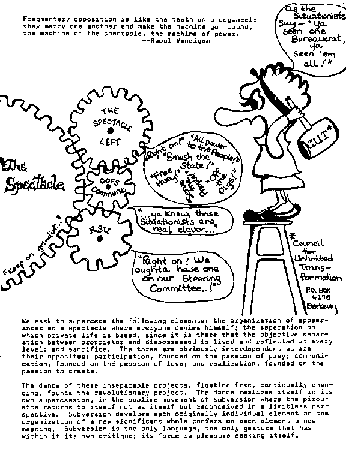
“Fragmentary opposition is like the teeth on a cogwheel:
they marry one another
and make the machine go ’round,
the machine of the spectacle, the machine of
power.”
(Raoul Vaneigem)
[On the Spectacle cogwheel it says “Keep on grindin’.”
The little woman poised to smash the machine is saying: “As the Situationists say
— ya seen one bureaucrat, ya seen ’em all!” The Spectacle Left cogwheel is
saying: “Right on!” “All power to the people!” “Smash the
State!” “Free Huey!” “Serve the People!” “Off the
Pigs!” The other oppositional cogwheels are responding to the woman: “Ya know,
those Situationists are real clever...” “Right on! We oughta have one on our
Steering Committee!”]
We seek to supersede the following elements: the organization of
appearances as a spectacle where everyone denies himself; the separation on which private
life is based, since it is there that the objective separation between proprietor and
dispossessed is lived and reflected at every level; and sacrifice. The three are obviously
interdependent, as are their opposites: participation, founded on the passion of play;
communication, founded on the passion of love; and realization, founded on the passion to
create.
The dance of these inseparable projects, floating free, continually changing, founds the
revolutionary project. The dance realizes itself in its own supersession, in the sublime
movement of subversion where the pirouette returns to itself not as itself but reconceived
in a limitless perspective. Subversion devalues each originally individual element as the
organization of a new significant whole confers on each element a new meaning. Subversion
is the only language, the only gesture, that has within it its own critique; its force is
pleasure seeking itself.
[February 1970. Signed “Council for Unlimited
Transformation.”]
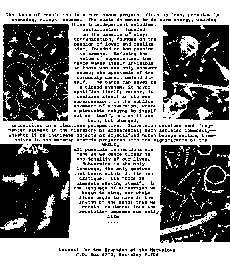
[Pictures of cells and microscopic creatures]
The dance of revolution is a continuous project, floating free, perpetually changing,
always focused. The music it moves to is pure energy, weaving three interdependent
melodies: participation, founded on the passion of play; communication, founded on the
passion of love; and realization, founded on the passion to create. Refusing the value of
appearances, the dance makes itself invisible to those who see only appearances; the
spectacle of the commodity cannot defend itself. The dance can never be a closed system,
it never mystifies itself; rather, it realizes itself in its own supersession, in the
sublime movement of subversion, where a pirouette returns to itself not as itself, not as
it was born, but changed, reconceived in a limitless perspective. Subversion devalues each
fragmented element in the hierarchy of appearances; each isolated commodity — whether
it be inanimate objects or objectified human beings selling themselves in the marketplace
— is projected into the significance of the WHOLE, all possible connections are made
as we dance closer to the totality of our lives. Subversion is the only language, the only
gesture, that bears within it its own critique. Its force is pleasure seeking itself. In
the language of subversion we begin to sing, our whole lives begin to move in the rhythm
of the song: thus we create the dance: thus the revolution becomes our daily life.
[February 1970]
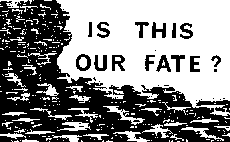
[Cover: picture of huge traffic jam]
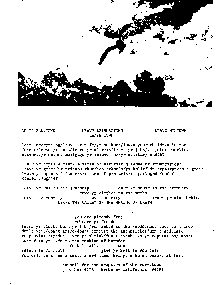
[Inside: picture of hawk flying over forest]
LEAVE PARKTOWN LEAVE LEISURETOWN
LEAVE MILTOWN
LEAVE TOWN
LEAVE THE VALLEY OF THE SHADOW OF DEATH
you are already free
embrace yr freedom
smash yr clocks / burn yr I.D. / run naked in the woods / make love to a
tree
don’t vote / don’t argue / don’t consult the authorities / don’t
abdicate responsibility / don’t see yr shrink / don’t establish yr reputation /
don’t sacrifice yr life to the machine of boredom
fuck it all. now
return to yr roots give yr Self to
yourself
you will be a new animal, a new human being, a human being, at last
[February 1970. Distributed door-to-door in the “Parktown” suburban tract of
Milpitas, California, by CEM members dressed in suits and ties.]
Since the publication of the CPE course catalogue and the opening proposal which addressed
itself to student control of the university and the educational process in general, we,
its authors, have been involved in an intense and painful period of self-criticism. The
line of thought which resulted in the essay “Ideas Are No Man’s Property”
has continued to a point which is in some ways a logical extension of our original
thinking, yet its conclusions radically differ from our original proposals.
In the interests of developing revolutionary clarity, we would like to share our
self-criticism with you. We will present below a fairly systematic critique of our
original ideas, followed by a new proposal.
Our introductory presentation of the functions of the university is a description of
what happens rather than why it happens. But its accuracy left a gap between what we could
see and what we could see to do to change it.
Our conclusion — that the educational process and our roles as students are
dehumanizing — leads us to further consider all activity in the capitalist spectacle
in the same way. We now see that our life lived as time which is not our own (not
consciously directed by our desires) necessarily becomes a network of roles which we
assume in order to survive in a way compatible with the positively reinforced structures
of the social “order.” The separation and objectification of this
time-beyond-our-control owes its structure and origins to alienated labor. This labor is a
way of “doing time,” of surviving, while simultaneously perpetuating by our own
efforts the system which enslaves us. In order to end our alienation we must refuse to act
out roles which further separate authentic human need from appearance.
Thus our conclusion in the catalogue — “The nature of this political process
. . . must be developed by us, by students as students” — was
insufficient. Though our anger was correctly placed, we did not go far enough. We should
refuse to accept the role of student. We should reject our specialized functions
completely. We will ourselves be total assholes if we accept the obvious fragmentation of
our lives. Our project is not to “encompass the construction of new roles for
ourselves” but to destroy the purely subjective categorizations which keep us from
transcending the poverty of automatic behavior, of alienated labor, of the voluntary
slavery of reformism.
We thus come upon a new (for us) view of social relations which goes beyond our
conception of a counter-institution. We have come to see any “new” institution
as the creation of another obstacle to unmediated human activity. “Institutions”
in their very nature become an artificial collectivity whose importance is independent of
individual desire expressed collectively. What is necessary is the destruction of
institutions and unnecessary restrictions of human activity, and the substitution of a
spontaneous and freely chosen form of social organization whose initial project must be
the abolition of class society and therefore of labor. The goal and process of such
activity is the continued transformation of daily life. We will accept nothing less and
therefore we proclaim AN IMMEDIATE END TO ACADEMIC REFORM. We can then pursue the only
real educational reform: THE TOTAL DESTRUCTION OF THE UNIVERSITY.
We are leaving the University, and urge our sisters and brothers to do the same.
Naturally, we will no longer serve as bureaucratic functionaries for the
“alternative” institution (CPE). Our knowledge of bureaucracy leads us to
believe that our withdrawal from its key positions will cause it to fall apart. This is
our hope.
—Alan Mulman, Diane Sunar
[Mulman and Sunar — whose names were falsely signed to this
leaflet — were anarchist founders and functionaries of a “Committee for
Participatory Education” at the University of California in Berkeley. This leaflet
was distributed at CPE registration, March 1970.]
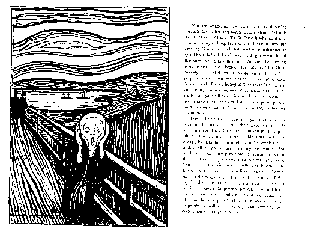
[Munch’s painting “The Scream”]
You are wandering now, once again (and again) through the endless and
boring debate about “What Is To Be Done.” What Is To Be Done is why right now
you are doing nothing. Instead, you choose to allow the Steering Committee and their
various functionaries to spend hours behind closed doors deciding how you should live your
lives, eating their own shit and then serving it up to you — the “People,”
the “Masses,” the Great Nobody — in their pseudo-revolutionary clichés.
You perpetuate your own powerlessness by accepting their Naked Lunch. These Ideological
Cops, these Bureaucrats-In-Training, are nothing more than mediators determining for you
your self-determination. In a true revolutionary moment there are no mediators: no cops,
no priests, no Academic Senates to be watched on TV, no Steering Committees.
These clowns try to convince you that you can build an effective strike under their
auspices even while you remain students. They present to you the false possibility of
revolutionary reform within a system that is always, by definition, an insidious
and alienating hierarchy. All hierarchies are alienating, no matter what mythical choices
they perpetrate. By remaining within the role of students you accept these nonexistent
choices. You consider the crisis in Cambodia a crisis immediate to your lives when in fact
your lives are devoid of crisis. At least the people of Cambodia and Vietnam are fighting
for their physical survival. You instead choose to continually ignore the poverty,
powerlessness, and boredom of your everyday existence. Until you realize that life must be
a perpetual crisis, the Marvelous and all its possibilities will forever evade you, and
even your own desperation will put you to sleep.
[April 1970. Distributed at the University of California in Los Angeles during a
period of widespread but passive student protest against the US invasion of Cambodia.]
[During this same period the CEM issued several other anonymous (and no longer
extant) leaflets at various UC campuses, including “Chancellor’s Memo” at
UC Santa Cruz (as you may have guessed, it wasn’t really from the Chancellor);
“Ecology Leaflet” (excerpts from Burroughs’s Naked Lunch signed
“Ecology Action” and littered all over the Santa Cruz campus); and “George
Winne Memorial” at UC San Diego (Winne was a UCSD student who had just burned himself
to death in protest against the war; the CEM leaflet, in sarcastic irony, suggested that
other students might appropriately emulate this gesture of self-sacrificial protest).]
[Another no longer extant CEM
leaflet-disruption left the following trace.]
GODARD IN BERKELEY
. . . The last sequence [of a Godard film being shown] showed a bloody
hand reaching out of the mud. Long live the Revolution. Lights, applause, here’s
Godard to answer your questions.
Godard immediately asked that the nearer of the two
obnoxious tv lamps focused on him be turned off, and it was. The strangest event of a
strange evening took place. A man — I didn’t see him long enough to notice
anything but dark hair — threw an explosion of leaflets into the audience and
vanished up the aisles. The leaflets contained two messages:
One, in English, called “The Meal” attacked
Godard as “a sorry clown,” a “hypocrite,” “the old pederast of
the youth revolution,” and attacked the audience for its “contemptible
acquiescence.” It concluded by predicting that “you (the audience) and your
so-called revolution will remain a childish mimicry of its own possibility.”
The other, printed parallel in French, called
“Le Repas” (“The Meal”) seems to be but is not a translation of the
English. Here, Godard is “a genius,” “a hero,” “a saint,”
“the prophet of the Youth Revolution.” The audience is praised equally fulsome
as “a room full of authentic revolutionaries ready to sacrifice themselves for the
creation of total rebellion,” and told that “you and your revolution will be the
stars of the next Godard movie.”
If the aim of these leaflets was to out-Godard Godard
in coyness and perversity of expression, the distributors came close. (Assuming that they
are not the work of Godard himself, or simply an inept translation.) Either way, to throw
the things up in the air and run was the very acme of chickenshit. Why not just hand them
out. Who were they afraid of. . . .
—Berkeley Barb (1 May 1970)
[The article failed to note that as the leaflets were distributed (by a
CEM member in priest’s garb) other CEM members were throwing tomatoes at Godard, who
unfortunately succeeded in ducking them.]
I
Woman’s everyday life embodies a critique of human history, including
a critique of the traditional revolutionary organization and its so-called New Left
alternatives. However, women are obscuring this critique by trying to define themselves in
terms of traditional revolutionary theory, which has in general merely tacked an obscured
discussion of the role of women onto its periphery. Women have failed to utilize their
lived critique of hierarchical society, limiting themselves to the same alienating modes
of revolt (Stalinist, for example) to which men have been confined.
The separation which women feel from history offers them an opportunity for critical
revolt. This opportunity is obscured by the expressed need to relate women’s
liberation to the traditional revolutionary struggles. This identification necessitates a
new relationship to men (i.e. to those men who participate in the traditional
revolutionary struggles). The ability of women to formulate a revolutionary praxis
consistent with their critique of history is restricted not only by the chauvinism of
leftist males, but also by the elementary theory and organization of the Left. It is at
this point that women’s liberation has offered the possibility of a critique of the
Left and of traditional leftist hierarchy. The extreme form of this critique has been
separation from “the oppressor” (i.e. men).
The predominant attitude of this separation (whether or not it is realized in a
separatist colony) is antagonism, distrust, and hatred. The separatist woman is defined by
this attitude: She has a social identity which can only be negative; it becomes merely the
negation of the traditional feminine identity. By merely finding a new role in which to
relate to men, she perpetuates her subservience to the world of appearances. Rather than
relate to women as individuals, she continues to define them through the juxtaposition (to
her, antagonism) of the sexes. She expends all her energy in that friction. She is
successfully protected from a submissive relationship with men; yet she submits to a
fragmented view of the world which is not of her own making.
II
In the moment of total rejection of the given social relationships, all things are
possible; instead, most women seek shelter in a structure whose very attractiveness is its
smothering and ultimately destructive familiarity. By allying themselves with
traditionalist revolutionary struggles — which seek to substitute one form of
oppression for another — women fail to utilize the moment of radical rejection. They
make alliances with the Left on its terms: in order to be admitted to the
exclusive club of authorized movements of the oppressed, they must accept the history of
the Left’s failure to bring into being a society without hierarchy. Thus, to the
extent that it links itself to the Left, the women’s liberation movement, discussing
its goals in traditional socialist terms, fails to note all the critiques of left ideology
which have been generated in the last fifty years, and perpetuates the hierarchy they
should be revolting against. Women thus support a “radical” movement which
suppresses them, whether that suppression takes the obvious form of male chauvinism in the
New Left or wage labor in the Soviet Union. At the same time they reinforce the
Left’s preoccupation with revolutionary prehistory and its alienated forms of
“revolutionary” reconstruction (such as party bureaucracy, and massive thought
control and denial of freedom during the “period of transition”).
It is the attempt to relate to traditional revolutionary theory — with its
mistaken emphasis on the necessity of state power and a “period of transition”
— which leads to the endless debate over job and economic status, caste and class,
and sexual identity. Because it is subsumed by a series of traditionalist
rationalizations, the analysis of female identity has not been developed into a total
critique.
III
Women’s liberation fails to realize that it is rebelling against an image of men
which is as superficial as the image of women they have rejected for themselves, and that
it is the very nature of the male role to be self-perpetuating because of its
characteristic dominance. By limiting the critique of psychological stereotypes to women,
the realm of the possible is drastically narrowed: a critique of male and female roles
should lead to a general critique of Role, and from there to a critique of all ideal
absolutes. In the past, the critique has only constructed another idealized essence —
the New Woman — to be revealed in the “post-revolutionary era.” Both the
New Man and the New Woman are mystifications; embracing these ideal types merely postpones
the necessity of throwing into radical question all that the revolutionary project must
encompass.
[Distributed at a May 1970 California women’s conference in Santa Cruz. Later
reprinted by 1044.]
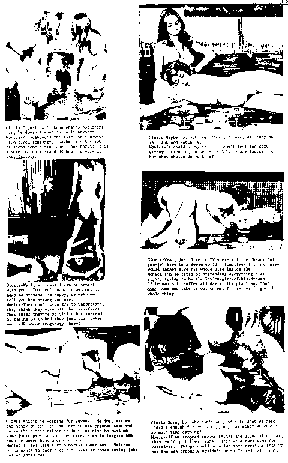
[Porn photos of two naked women making love,
with dialogue added underneath]
GLORIA: I just don’t know what’s
bothering him, he doesn’t want to do it anymore.
MONICA: My husband’s the same, he’s always
“too tired tonight.” Maybe it’s his job, he keeps complaining about how
boring it is. I sure couldn’t stand 10 hours a week at that factory.
GLORIA: Maybe so, but when they get home, all they do is
drink and watch TV.
MONICA: It could be my fault. I don’t feel too sexy
either. Cleaning house is as dull as any factory job; but what choice do we have?
GLORIA: Well, at least I can be honest with you. You
don’t want to own me, or make me pretend I’m happy, or make me tell you how
strong you are.
MONICA: They don’t even try to understand, they think
they make all the sacrifices. They think they’re so virile but instead of taking us
to bed they just play poker and talk about imaginary whores.
GLORIA: Yeah, just like on TV where all the “beautiful
people” live in a dream world. Sometimes I think Harry would rather live his whole
life inside the TV.
MONICA: I’m so tired of pretending everything’s all
right, trying to be the Revlon-girl-of-his-dreams. If he wants to suffer all day at the
plant and then come home and take it out on me, I’d rather forget the whole thing.
GLORIA: What’s he working for anyway? He just wastes the
money on toys to show off to his friends that end up in the closet gathering dust, or else
he buys me some junky present and then expects me to forgive him when he comes home a
drunken slob.
MONICA: I feel like such a martyr sometimes. Neither of us
wants to sacrifice our lives to these boring jobs, but we gotta eat.
GLORIA: Sure, but why can’t we just take what we need?
There’s enough for everybody, why pay money we wasted so much time earning?
MONICA: If we stopped buying things and lived like that, they
could quit their jobs. Then we’d have time for ourselves. Things could be a lot more
exciting that way and the men probably wouldn’t be so “tired” at night.
[June 1970. Intended for distribution on the freeway at rush hour near the Lockheed
Aircraft factory in Sunnyvale, California. But the CEM broke up before this was carried
out.]
Leaflets issued by the Council for the Eruption of the Marvelous (CEM),
January-June 1970.
No copyright.
[Bureau Prehistory]







